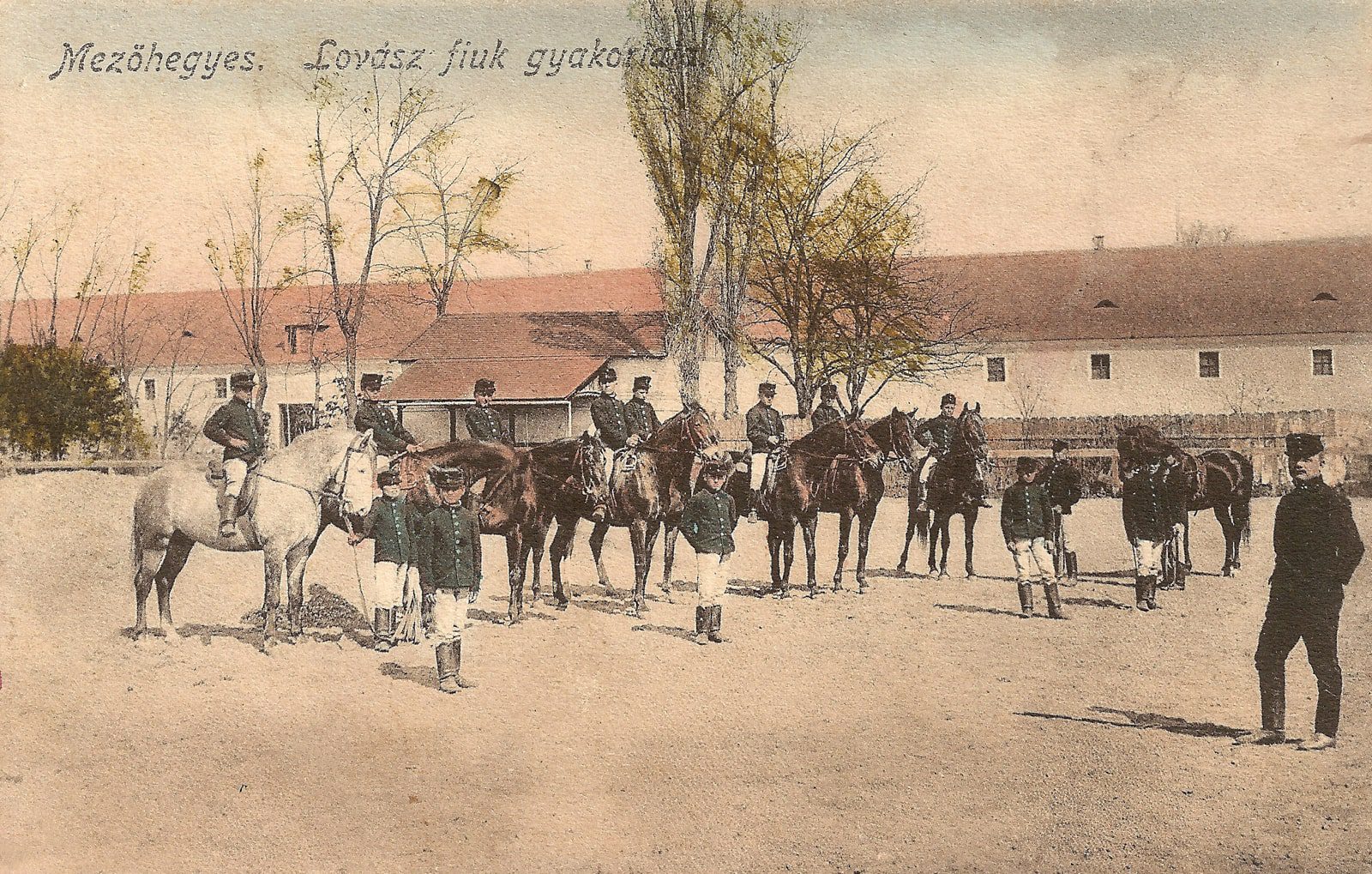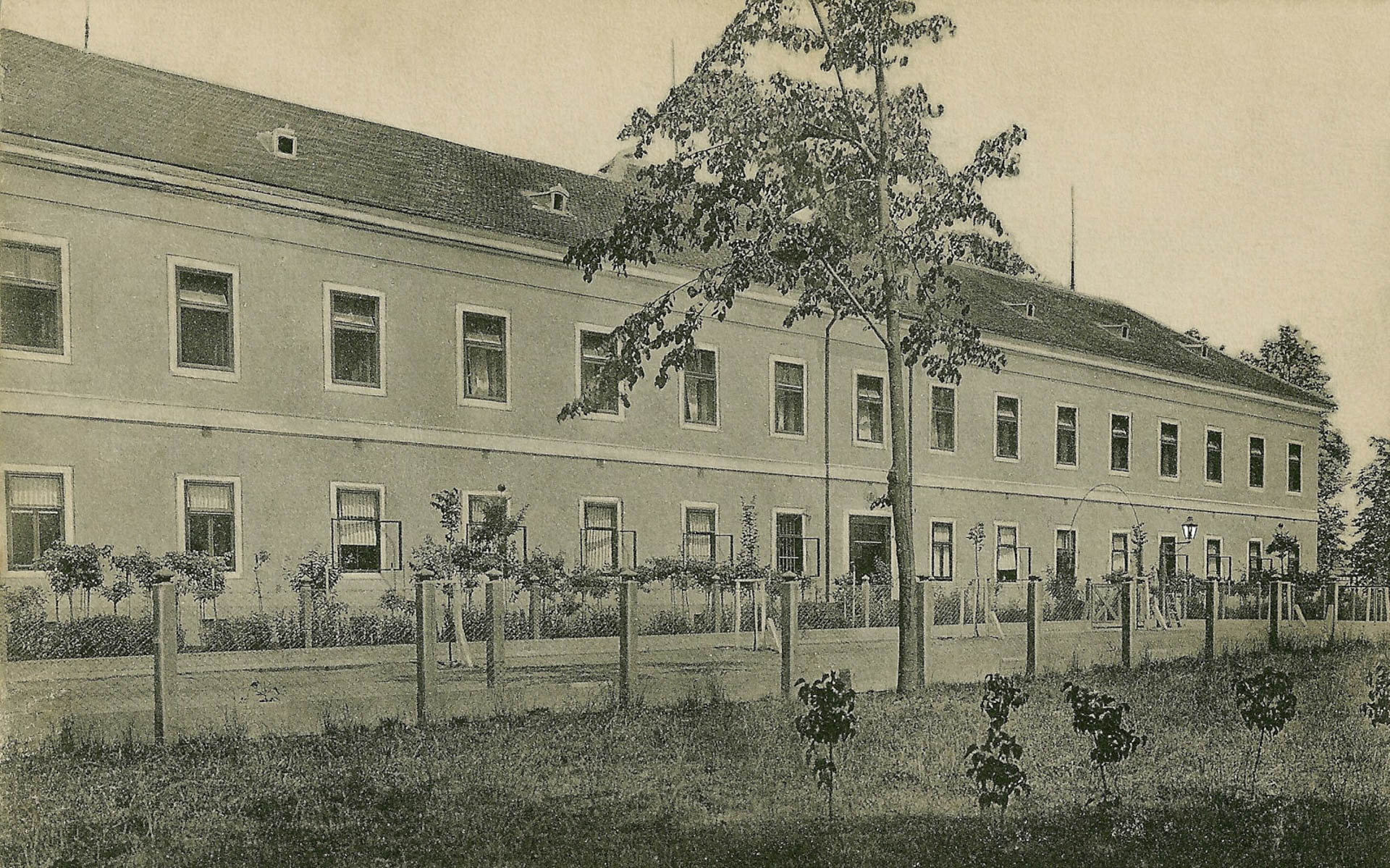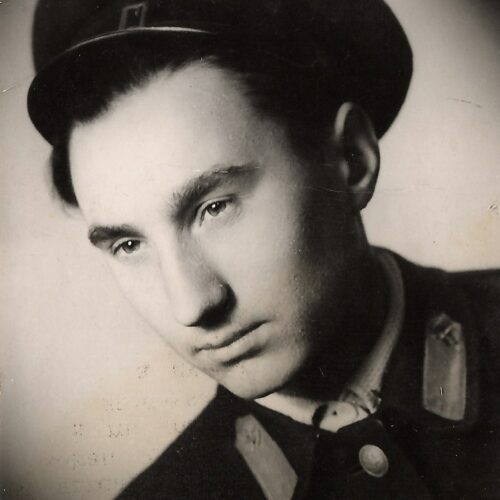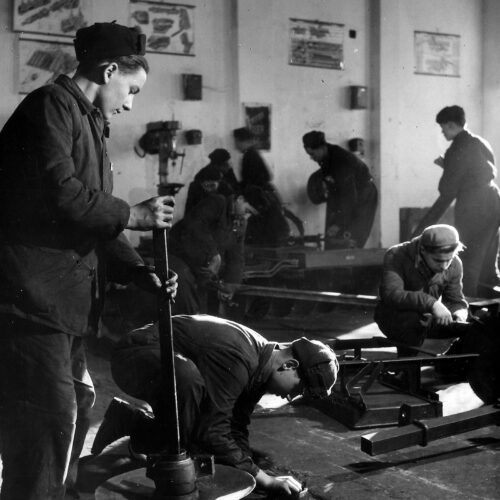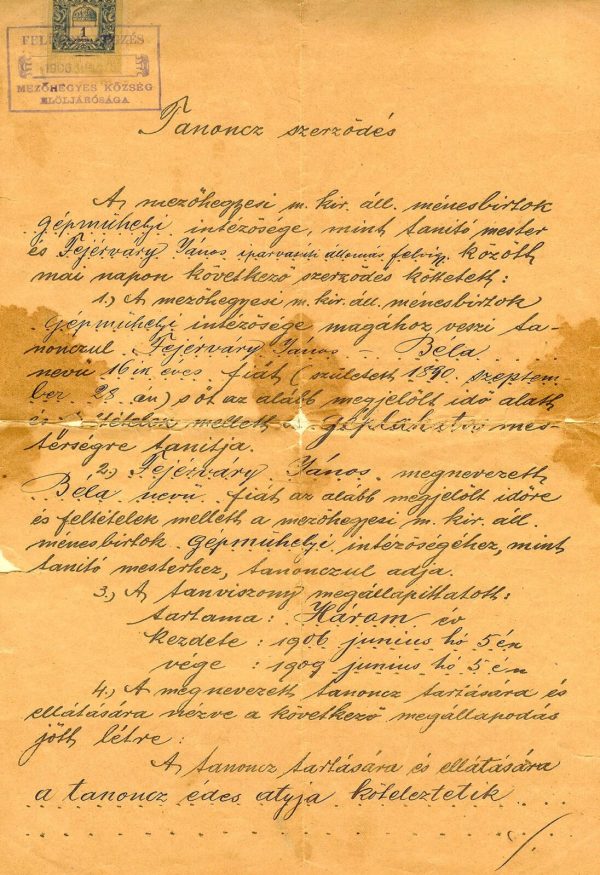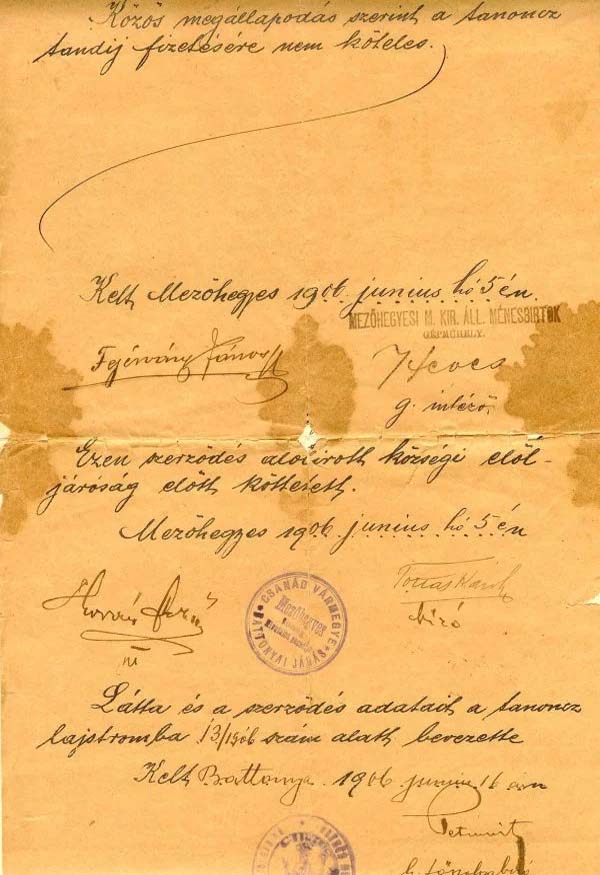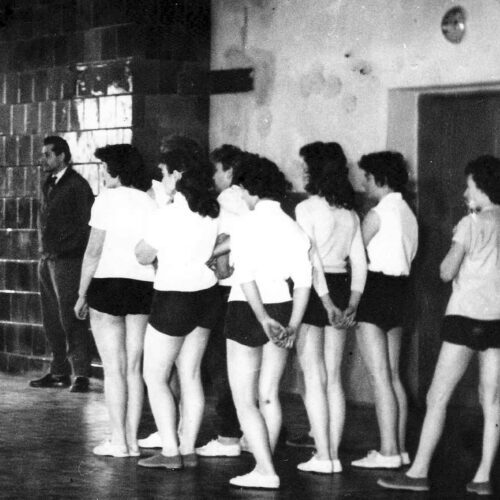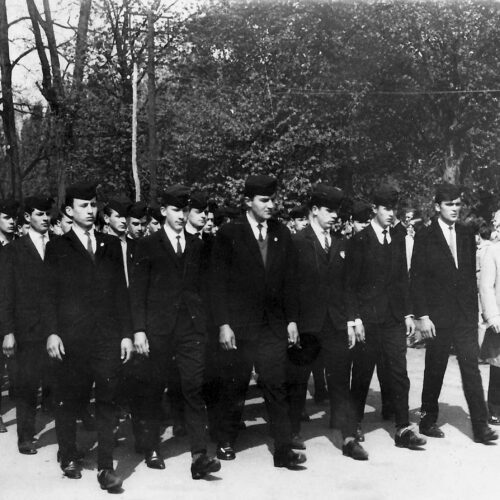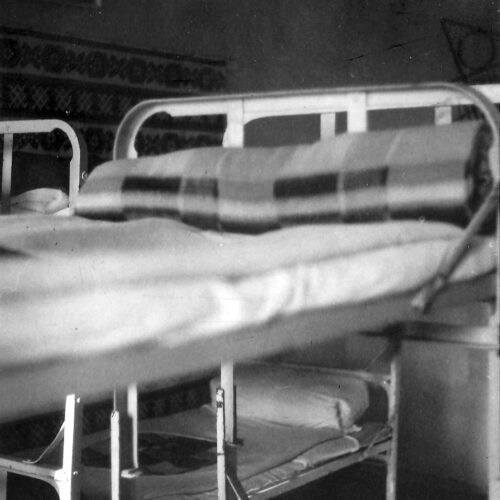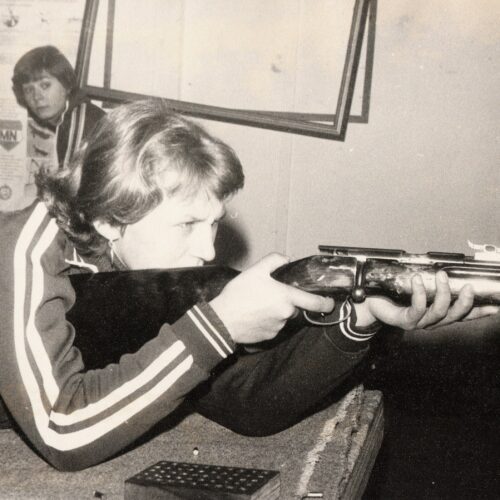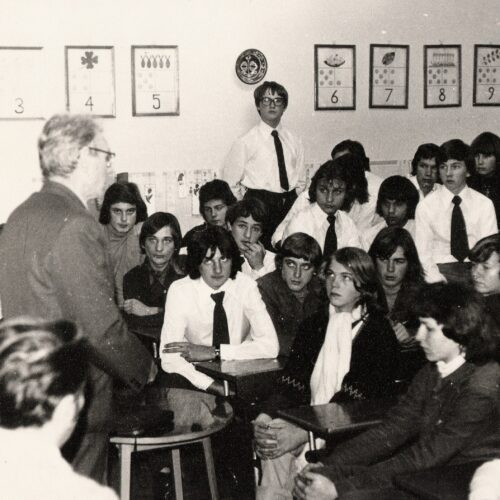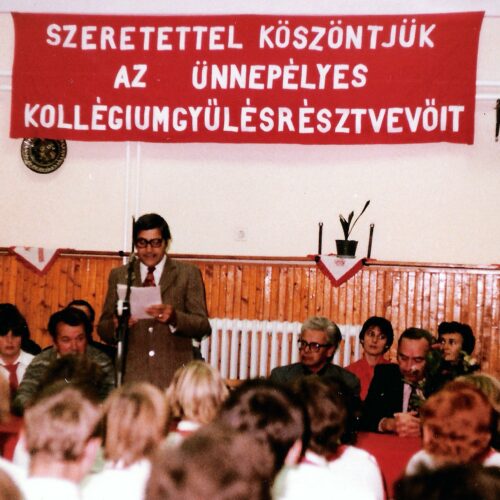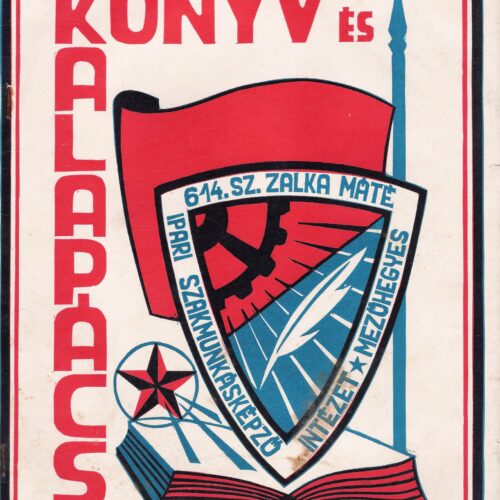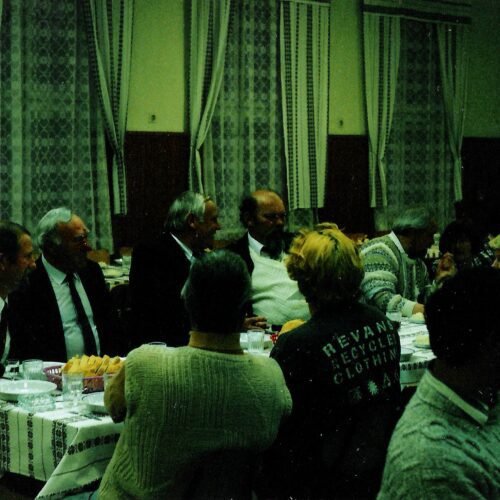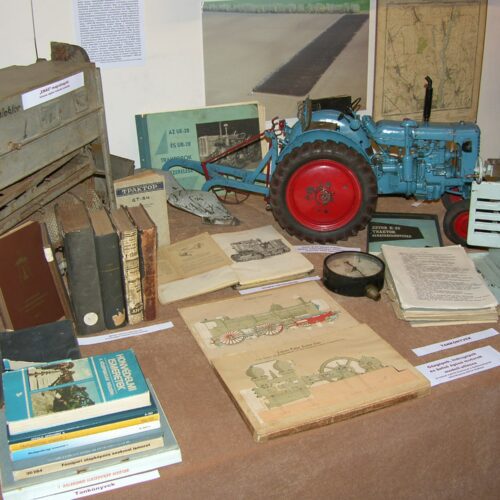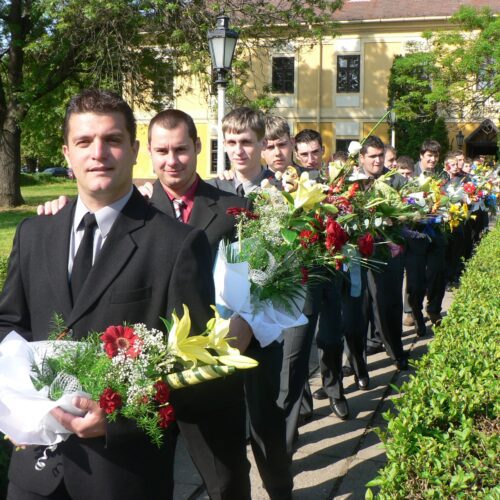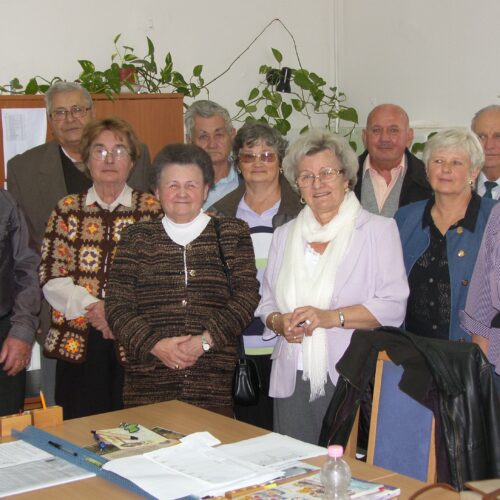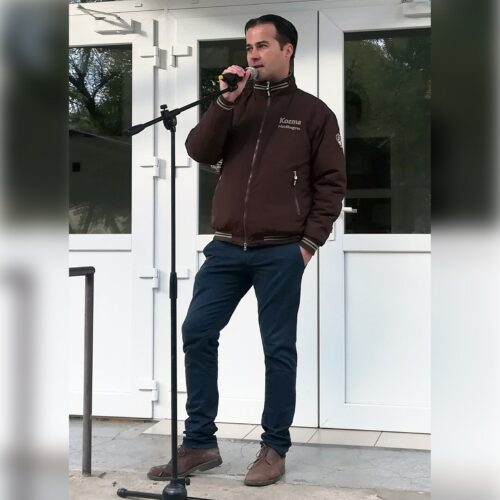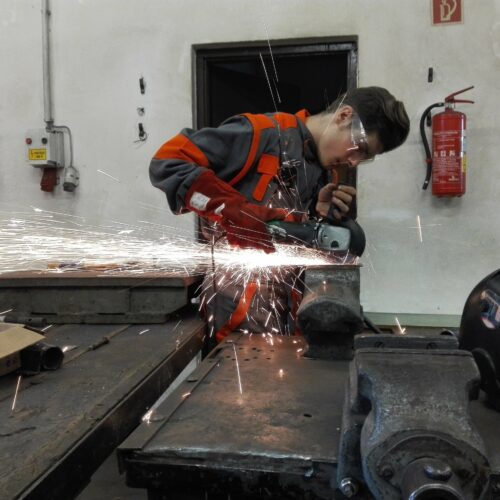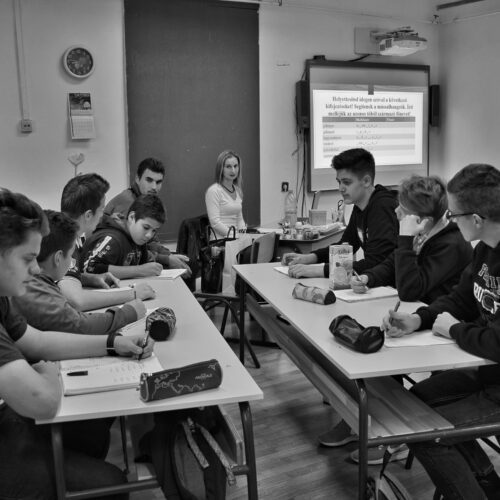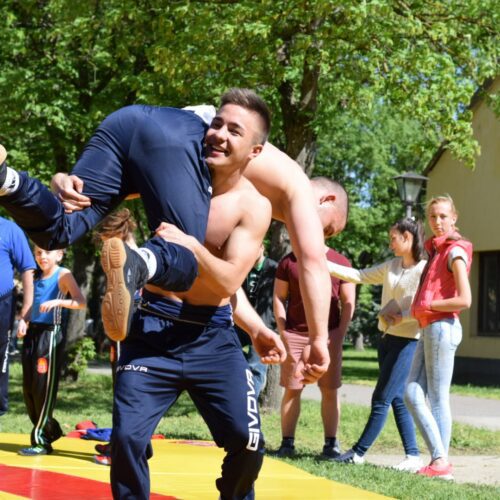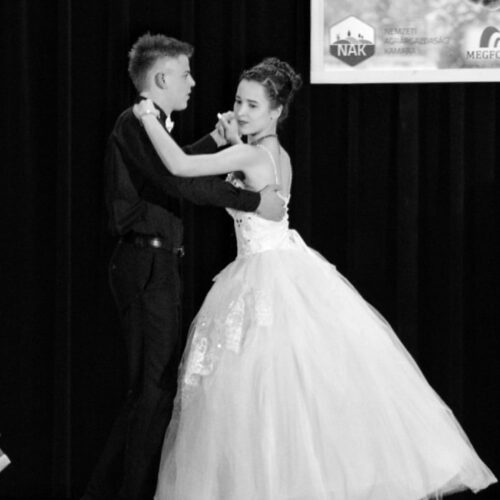School History
Changes in the name of the school and its owner, sites and buildings
In 1911, the municipality of Mezőhegyes set up the Lower Industrial Apprenticeship School within the framework of the elementary school, with two grades. From the school year 1914-1915, it continued its work under the name of Municipal Industrial Apprenticeship School of Mezőhegyes, with three grades. During this period, theoretical education took place in the buildings of the elementary school, under the guidance of the elementary school staff. From the academic year 1950-1951, the vocational training became autonomous and was transferred to the Labour Reserve Office (MTH), but real autonomy, with the organisation of an independent teaching staff, began from the academic year 1954-1955. Theoretical instruction was given in the premises of the Gödör restaurant (now the elderly people’s club) and in the Kisintézet (now the Express ABC), converted from the Hunters’ restaurant. In 1955, the Ministry of Labour (MüM) took over the management of the school, which was renamed MüM Industrial Apprentices’ Institute No. 614 Mezőhegyes, and in 1963, in accordance with the custom of the time, it took the name of Máté Zalka. During this period, the Kisintézet proved to be really small due to the increase in the number of students, so the school was given the property at 23 Kozma Ferenc Street, the current seat of the school.
The present complex of buildings of the School of the Stud Farm is located on the site of the former veterinary hospital, while the teacher's building is the former Villa of head veterinarian.
The Hungarian National Archives have a surviving 1880 floor plan of the Romantic-style house, which, according to the plan, was occupied by ‘Head Veterinary Officer Neumann’ at the time of the survey. The very first building of the school’s headquarters is the longitudinal stable called Marode Stall, an integral part of the central representative courtyard, which is now the workshop wing of the main building.
The iron hoops used to tether the animals can still be seen today. The Stud Farm had a veterinary surgeon when it was founded, and later a number of doctors and assistants supervised the livestock in addition to the chief veterinary surgeon. The importance of the farm was great, as there were several outbreaks of epidemics which decimated the herd, and in wartime the number of injured or sick animals – some of them war booty – on the Stud Farm increased considerably.
The first site plan and map of any serious value was drawn up in November 1810.
At that time, the hospital consisted only of a longitudinal stable, which was an integral part of the representative block of buildings, i.e. its construction was completed before November 1810, probably to the design of János Hild. This position corresponds to the location of the south workshop wing of the present main educational building.
The L-shaped extension to the horse hospital may have taken place between 1827 and 1869, perhaps as a result of the epidemic that decimated the livestock in the 1850s, or around 1864, when the isolation stables were built to the east of the hospital. The most reliable cartographic source for the buildings is the 1882 cadastral map. By this date, the main veterinary villa with outbuildings and another building in the second courtyard of the horse hospital are already standing, their date of construction is unknown.
After the World War II, the complex was converted into a machine station, the L-shaped veterinary hospital building was converted into a machine shop, another L-shaped flat-roofed social building was erected opposite it, framing the courtyard in mirror symmetry, and a 60-person workers’ hostel was built. In 1969, the buildings of the machine station were converted into a school and workshops, and the workers’ hostel into a dormitory. The workshop wing of the main building and the other workshops and the dormitory were given a flat roof, and the courtyard was covered with open steel-framed machinery belts. The work was completed in 1970, and the buildings have been used for educational purposes since then. In the 1980s, workshops and classrooms were created under the open machinery belts by building facade walls and, in some places, attic slabs. In the late 1990s, the facades of the workshop wing of the main building were renovated, with a new tiled roof and new windows. This was followed in the 2000s by the renovation of the classroom and workshop building, now known as the “New Building”, which was converted from the 1960s L-shaped flat-roofed social building. The Kossuth Street wing of the building was demolished and a high roof with a tiled roof was added, identical to the main building. The southern end, closer to the teacher’s building, was renovated, with central changing rooms and a water closet on the ground floor and two classrooms on the roof. The remaining rooms at the north end continued to be used as workshops without renovation.
In 1980, the Kisintézet was exchanged for the Hangai building. The house is popularly named after Tamás Hangai from Csanádpalota, who rented and ran it between the two world wars. The house, originally designed as a Pest-Arad stagecoach station and inn, was built by József Jung in 1789 and has been visited by such notables as Count István Széchenyi, Governing President Lajos Kossuth and Emperor Franz Joseph I. The building is currently undergoing a complete renovation and will be given a new function. It will house the offices of the National Stud and Educational Farm, and on the ground floor there will be an interactive visitor centre, a café and a gift shop for guests visiting the model farm.
In autumn 2019, due to the ongoing major investments at the School’s headquarters, the maintenance company has built a new premises for three academic years in the former sugar factory kitchen building (5820 Mezőhegyes, Hild János utca 19; cadastral parcel 28/13). The Stud Farm has converted the former sugar factory tennis court into a gym in order to ensure the smooth organisation of daily physical education during the period of the investments. For a detailed report on the works at the school’s headquarters, please see the Head Teacher’s welcome speech.
Our school was a municipality (later town) maintained institution until the change of the system, then from 1993 it was run as an independent school by the Municipality of Békés County until 2007.
On 1 July 2007 the school was merged with the Hunyadi János High School of Mezőkovácsháza. As this integration did not prove to be viable, the county government attached the school to the Harruckern János Public Education Institution from the 2008-2009 school year. The Kozma Ferenc Agricultural Vocational School and Dormitory is named after Ferenc Kozma (1826-1892), the secretary of the Minister of Agriculture and later a councillor, one of the most prominent figures in Hungarian horse breeding. He developed a comprehensive breeding concept covering all stud farms. He stopped thoroughbred breeding in Mezőhegyes as not being appropriate for the area and set up the following stud farms. Thanks to the breeding instructions prescribed by Ferenc Kozma, the Mezőhegyes horses have received the most prestigious international awards. As of 15 August 2017, Kozma became a school of the National Stud and Educational Farm. In the 2019/2020 academic year, the name was changed to Kozma Ferenc Mezőhegyesi Technical and Vocational Secondary School and Dormitory, and from 1 July 2020 to Mezőhegyesi Technical and Vocational Secondary School and Dormitory. We continue to pay tribute to Ferenc Kozma, including by naming the school’s scholarship programme.
The school principals
1911-1916
Földes Ferenc
1911-1916
1916-1930
Kiss Károly
1916-1930
1930-1945
Horváth Dezső
1930-1945
1945-1947
Nagy Sándor
1945-1947
1947-1950
Gulácsi Zoltán
1947-1950
1950-1951
Bolemán Dénesné
1950-1951
1951-1952
Haránt Mihály (mb.)
1951-1952
1952-1962
dr. Kocsis Ferenc
1952-1962
1962-1967
Haránt Mihály
1962-1967
1967-1992
Magyaróvári Mihály
1967-1992
1992-2002
Csanádi István
1992-2002
2002-2003
Kiss Mihály (mb.)
2002-2003
2003-2006
Csanádi István
2003-2006
2006-2007
Agonás Margit (mb.)
2006-2007
2007
Berka Róbert (mb.)
2007
2007-2008
Plesovszkiné Ujfaluczki Judit
Berka Róbert intézményegység-vezető helyettes
2007-2008
2008-2010
Zámbó András
Varga Sándor oktatási igazgatóhelyettes, a 2009/2010-es tanévtől oktatási telephelyvezető
2008-2010
2011-2012
Mikulán Róbert
Gyuri István oktatási egységvezető
2011-2012
2012-2013
Kovács Zsuzsanna
Sándor Zoltánné igazgatóhelyettes
2012-2013
2013-2014
Kovács Zsuzsanna
Mucsi Balázs oktatási egységvezető
2013-2014
2014-2015
Kovács Zsuzsanna
dr. Malatyinszki Szilárd intézményegység-vezető
2014-2015
2015-2016
Tarkó Gábor (mb.)
2015-2016
2016-
Tarkó Gábor
2016-
The professions taught since the school was founded
From 1911 to 1945, the school taught the trades of ironmonger, cooper, locksmith, machinist, iron founder, blacksmith, tailor, boilermaker, carpenter, tradesman, shoemaker, saddler, harness maker, brass maker, chimney sweep, electrician, hairdresser, carpenter, butcher, coach wright and blacksmith. The main profile was that of a carpenter. On average, between seven and ten of the above trades were taught each year, depending on the school’s capacity and the needs of the environment.
From the 1961-1962 academic year, the main profile became the nationally registered agricultural mechanic profession. Until 1947, the school only enrolled boys, after which girls could also be enrolled, mainly in the women’s clothing trade, but girls could also be enrolled in the ironmongery trade, in accordance with socialist principles. In 1948, the first tractor school in the country was started here, and the first woman in the country to work with a tractor was Júlia Kardos from Mezőhegyes. In 1972, the Education Act introduced a re-profiling of the trades, with nine trades being taught (mechanic, welder, machinist, locksmith, electrician, carpenter, dressmaker, mason, carpenter-plasterer). During this period, 21% of the curriculum and lessons were general knowledge, 15-19% vocational theory and 60-64% practical training.
After the change of regime, vocational training underwent changes and the professional profile had to be broadened. In addition to the traditional vocational training, a vocational secondary school class in agricultural mechanics was started in 1988, and in 1993 a vocational secondary school class in clothing was added for a short period. In 1995, intensive training was introduced, where young people with a vocational qualification could take the baccalaureate examination in two years in full-time training (this form of training was discontinued at national level in 2002).
From 1996 to 2002, our school had a secondary school with a law enforcement faculty. This was developed into a secondary school for law enforcement – later called a vocational secondary school in the Police and Civil Service sector – which was phased out from the 2021/2022 school year onwards, and was supplemented by a course for graduates in Security Officer 2 and Security Officer 1.
Pupils could also take examinations in personal security and security guarding.
Vocational education and training also underwent significant changes between 1998 and 2000. For two years, pupils studied general subjects, attended career guidance sessions and then received vocational training in one of the occupations listed in the OKJ (National Training Register). In the age of school integration, frequent and often ill-considered changes in the structure of training have had a negative impact on the institution’s enrolment rates.
Since 2017, when the institution regained its autonomy, enrolment has been on an upward trend again. Following the re-profiling, the focus has shifted to agricultural training: the Ostler; Horsebreaker and Horseshoer courses; Agricultural Mechanic, Agricultural Machine Repairer courses; and the newly introduced Gardener course. For the new training, the school has been accepting a small number of pupils with special needs from the 2018/2019 academic year. Our scholarship programme provided a net basic scholarship of HUF 20,000 per month for gardening students with mild intellectual or physical disabilities enrolled in Year 9. We built a greenhouse and created a model garden. Our students finished in the top six in the 2016 national “Save a Garden” programme – receiving a ministerial certificate and a valuable gift package.
In addition to its agricultural courses, Kozma continued for some time to offer traditional law enforcement training at the vocational high school and the highly traditional and marketable trade of Welding at the vocational college. In addition to youth training, there was a significant number of two-year full-time adult education courses and two years of intensive training after the vocational qualification to obtain a school-leaving certificate.
From the 2020/2021 academic year, our aim is to create a multi-purpose vocational training institution with a pure profile in agriculture. In the technical school, we will train agricultural machinery technicians and agricultural technicians, with the latter offering a choice of specialisation in crop or livestock production. In the vocational school, we continue to train agricultural mechanics, while students enrolled in the Farmer course can choose between the professions of horseman, animal breeder or crop grower. The range of training courses is tailored to the traditions of the institution and to the labour needs of the stud farm and the region. The former vocational training courses (Horsebreaker, Horseshoeing, Agricultural Machine Repair) are taught in adult education courses.
The school's main base companies; forms of training
From 1911 until the school became independent, practical training took place in the machine shop, architecture and district workshops of the Hungarian Royal State Stud Farm, as well as in the workshops of a few small craftsmen. The school had its own workshop, so that about 30% of the practical training, especially the basic training, could be carried out in the school workshop. Those who could not find a place or who did not have an instructor suitably qualified for their chosen profession were placed in companies (scattered training). Second and third year students were given real work experience in company workshops. The most important base companies were the Stud Farm (later State Farm, Mezőhegyes), the Mezőhegyes Sugar Factory, the Mezőgep in Mezőovácsháza, the MOM in Battonya, the EVIG in Mezőovácsháza, the Szabadság TSZ in Végegyháza and the Chemical Industry Cooperative in Tótkomlós. In the 1970s, twenty-three companies and six artisans were involved in the practical training of students. Unfortunately, these enterprises gradually closed down after the change of regime, so that practical training became almost entirely the responsibility of the school workshop. The school workshop is still a so-called production workshop, and the sale of the workpieces produced here contributes to the school budget. Since 1989, the school has also been used for the environmental inspection of motor vehicles, and the diagnostic equipment is still used today for the basic training of field technicians in the sector.
Special mention should be made of the training of adults. In response to the needs of companies, the school regularly organised further training for skilled workers and training for a second trade. From 1973, an attempt was made to start evening school courses at the grammar school, but it was the Vocational School for Apprentices that became the successful and sought-after form of training.
Currently, the Stud Farm is the sole and exclusive dual training partner of the school.
Apprenticeship in Mezőhegyes before 1945
The period from 1911 to 1945 was characterised by a strict enforcement of school attendance and the teachers’ concern for the moral education of the apprentices. Unjustified absenteeism was rampant, and the number of justified ones was few. Misbehaviour was punished by disciplinary sanctions (admonition, reprimand), and corporal punishment of pupils was not uncommon. Good pupils received praise and book prizes.
Under the ‘Industry Act’, the condition for becoming an apprentice was to have completed six grades of primary school. Exceptionally, fewer classes were allowed, but then a preparatory class had to be organised and the school term was extended by six months. From 1923, only apprentices over the age of fourteen were allowed to sign an apprenticeship contract. The apprentice’s working time was twelve hours, with half an hour in the morning and afternoon and an hour’s break in the afternoon. Medical fitness was also required, and from 1922 there were career guidance organisations.
In Mezőhegyes, the children of industrial families were taken on as apprentices in the central machine repair workshop after the age of 14. During the first year, the apprentices were familiarised with all the skilled work in the workshop. Their working hours were from 6 a.m. to 6 p.m. They attended school twice a week from 14-18 hours. On Saturdays, they were obliged to attend the Levente-education and on Sundays, the church holy mass. The apprentices, gathered from the farms, were housed in the Hangai guest house.
It was the duty of the apprentices to light the stoves and prepare the tools before starting work. In the evening, after finishing work, they cleaned up the workshop. Being an apprentice in the machine repair workshop was a privileged position, better than being an independent artisan, because the apprentices did not have to take part in household chores.
After their apprenticeship years, young people worked for three years as assistants. They did self-employment cheaply, and this was a big saving for the machine shop. Their wages were between 2 and 8 “filler”, depending on the grade. At that time in Mezőhegyes, the wage of an industrial worker capable of independent work was the same as that of a first-class maid.
„Tanoncz contract” (1906)
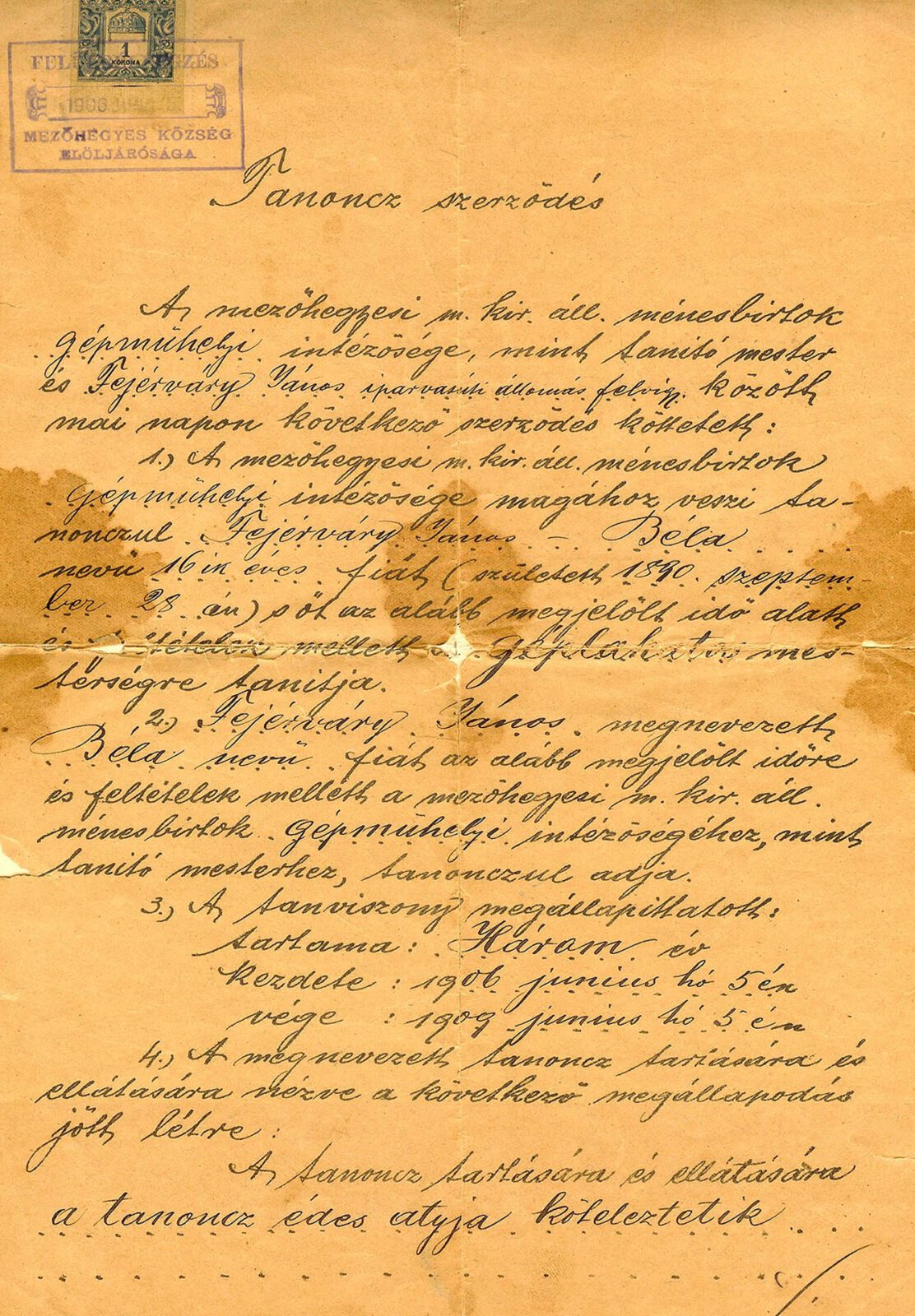


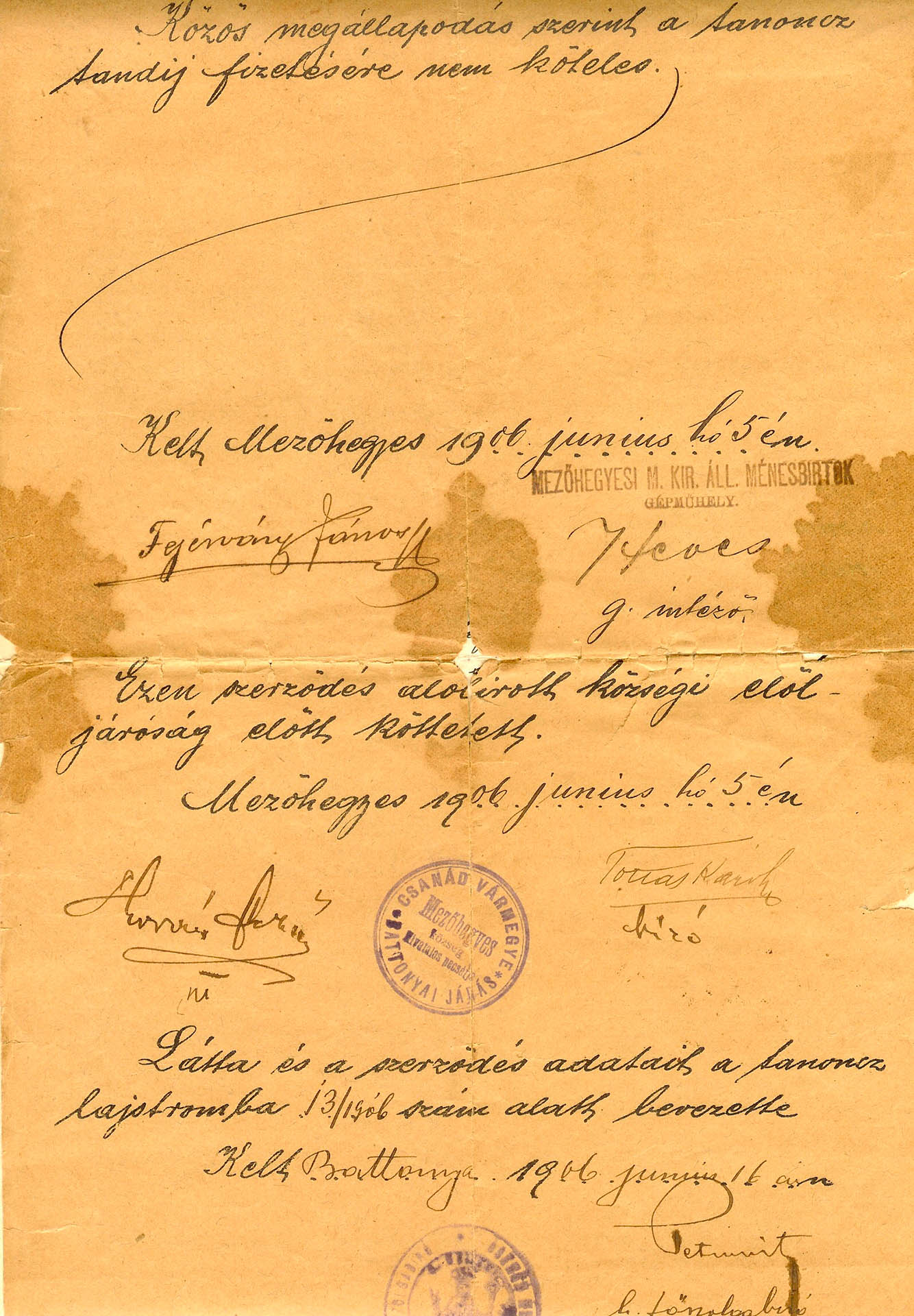


„Tanoncz szerződés” (1906)
Education in schools after the Second World War
After the introduction of independent vocational training, the Mezőhegyes Vocational Training School always took great care to help students with their studies. This was done through tutorials, specialised groups, study competitions and field trips. From the 1960s onwards, house, county and national competitions and the STC (Apprenticeship of Excellence) competitions were a regular feature. The school’s pupils achieved good results in these competitions. The school had between five and ten specialised workshops a year (e.g. modelling, go-karting, handicrafts, photography and radio). Music education was outstanding, although vocal music was not part of the vocational curriculum. In the 1961-62 academic year, the Szeged Cultural Festival awarded the first prize to the mandolin orchestra. The boys’ choir, formed in 1971, performed successfully at several festivals, mainly with movement songs, and was awarded a silver-coloured rosette. At the initiative of the KISZ (Communist Youth League) organisation, a Youth Club was set up in the basement of the Small Institute, which soon became one of the school’s cultural centres. In the 1970s, the school also had a well-functioning literary stage, and the school library, which was constantly expanding, helped to deepen pupils’ knowledge.
From 1957 and onwards, the KISZ helped the pupils to learn through its various movements and organised their leisure activities. The Vocational School of Mezőhegyes made it a priority to educate its pupils in the field of defence, which helped prepare them for military service. Unforgettable experiences for the pupils were the events of the Defence Days and the shooting competitions. The material, technical, intellectual and ideological basis of defence education was the MHSZ (Hungarian Defence Association), founded in 1953, and the Youth Guard section. On 11 May 1964, the school shooting range was inaugurated, which, in addition to defence education, also served law and order training (the successor to the MHSZ continued to operate as the Rifle Association from 2005). With the phasing out of the Law Enforcement and Civil Service sector training, the shooting range was demolished in 2020 and a swimming pool may be built in its place in the near future.
Due to the nature of the school, pupils had to do a lot of physical work and therefore needed to develop their stamina – sport became an integral part of their daily lives. Over the years, several departments have been successful and pupils have achieved success in prestigious sporting events. From the 1960s onwards, field trips, factory visits, excursions, camps abroad and at home were regularly organised.
After 1945, pupils received a wide range of benefits: scholarships, working clothes, personal protective equipment, toiletries, and free textbooks for a small fee. Meal costs were very low, reduced meals were often organised, and students could sign a study contract which provided them with a job. This was complemented by free medical examinations and health insurance, and of course free access to clubs, sports and school events. Needy and deserving pupils were also eligible for grants.
After the change of regime, as funding became scarcer, most of these benefits were withdrawn and the structure of leisure activities changed. Student life is organised by the DÖK (Student Self-Government), and at county and national level the competitions are dominated by students studying equestrian trades, field engineers and police officers.
Our traditional events are the Vocational Day (open day, career orientation event), the Advent Day, the “Varnyúavató” (freshman ball), the prom, the “Old Times Mayale” (student’s day) and the graduation ceremony. The “Birtok camp” is included in the school’s professional programme under the heading “the institution’s tradition system”.
Increasing the number of students; home at school - a presentation of our dormitory
The school in Mezőhegyes initially provided vocational training for pupils from the local area, and later for pupils from the local area and surrounding villages. Until 1949, the average number of pupils per year was between 50 and 70. In 1954 there was a jump in the number of pupils (235). From then on, the number of students increased steadily each year, peaking in the 1968-1969 school year with 809 students. In the socialist era, the number of pupils reached a low of 338 in the school year 1978-1979, and then remained at a low of 340-360 until the change of regime. By the 2006-2007 school year, the number of pupils had increased to 611, but integration efforts and the deterioration of the demographic situation in the region led to a further decline. It reached a new historic low of 178 at the end of the 2014/2015 school year. In the 2023/2024 school year, the institution received pupils from 94 municipalities, with a total of 309 pupils (35 of them from Mezőhegyes, 129 pupils from the incoming population and 145 pupils from the colleges). A further 31 pupils have taken up adult education with the school, doubling the number of pupils in eight years. While in 2015, only 57 pupils applied for the school’s courses when the school ranked pupils in places 1-3, in 2023, 177 pupils applied for 225 places in the secondary admission procedure. The school has active communication, a functioning career strategy and a well thought-out professional development programme. The school’s enrolment area is constantly expanding and widening. The number of pupils could reach 350 in September 2024.
With the expansion of the enrolment area, it has been necessary to accommodate pupils in dormitories. In the initial period, rural pupils were accommodated in the so-called Greek hostel on the Battonya road, but pupils also lived in sublets. As the number of students increased, it became necessary to set up a student hostel, which was converted from the workers’ hostel of the machine station on the present site of the vocational school. Initially it had a capacity of 60 pupils, but after extensions it could accommodate 130-140 pupils. The home, and later the dormitory, sought to provide a real home for the pupils. They were given all the help they needed to learn, enjoyed colourful leisure activities, learned the basic rules of coexistence, tolerance towards others, tidying up their surroundings, and the honour of work. The college is associated with prestigious events, quizzes, lectures, hikes, intimate celebrations, and noteworthy workshops. Among the latter, the woodcarving course led by József Bulik stands out. Since 2015, the number of students has tripled, and the school now welcomes students from 74 municipalities. Accommodation is provided free of charge, including at weekends, with a compulsory return trip every month. The new dormitory has 50 rooms and can accommodate 150 pupils.
After the millennium
The Mezőhegyes Technical and Vocational Secondary School and Dormitory has it all in one place: classrooms for theoretical education, workshops, a dormitory for rural students, a sports hall, a library and a dual training centre – all in a setting that is becoming more beautiful every year, in the heart of a small town with a historic air.
Tarkó Gábor
Head Teacher
Literature used:
Mihályné Tarkó.
The history of apprenticeship training in Mezőhegyes.
Mezőhegyes Notes 8.
Város- és Környezetvédő Egyesület, Mezőhegyes, 2006.


